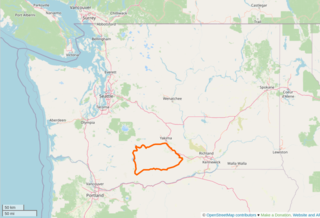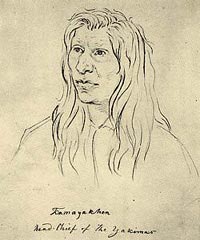
Yakima is a city in, and the county seat of, Yakima County, Washington, United States, and the state's 11th most populous city. As of the 2020 census, the city had a total population of 96,968 and a metropolitan population of 256,728. The unincorporated suburban areas of West Valley and Terrace Heights are considered a part of greater Yakima.

Yakima County is a county in the U.S. state of Washington. As of the 2020 census, its population was 256,728. The county seat and most populous city is Yakima. The county was formed out of Ferguson County in January 1865 and is named for the Yakama tribe of Native Americans.

Interstate 82 (I-82) is an Interstate Highway in the Pacific Northwest region of the United States that travels through parts of Washington and Oregon. It runs 144 miles (232 km) from its northwestern terminus at I-90 in Ellensburg, Washington, to its southeastern terminus at I-84 in Hermiston, Oregon. The highway passes through Yakima and the Tri-Cities, and is also part of the link between Seattle and Salt Lake City, Utah. I-82 travels concurrently with U.S. Route 97 (US 97) between Ellensburg and Union Gap; US 12 from Yakima to the Tri-Cities; and US 395 from Kennewick to Umatilla, Oregon.

Toppenish is a city in Yakima County, Washington. As of the 2020 census, the city population was 8,854. It is located within the Yakama Indian Reservation, established in 1855.

The Yakama are a Native American tribe with nearly 10,851 members, based primarily in eastern Washington state.

The Yakama Indian Reservation is a Native American reservation in Washington state of the federally recognized tribe known as the Confederated Tribes and Bands of the Yakama Nation. The tribe is made up of Klikitat, Palus, Wallawalla, Wenatchi, Wishram, and Yakama peoples.

Kamiakin High School is a public high school in Kennewick, Washington, the second of three comprehensive high schools in the Kennewick School District. Kamiakin opened in the fall of 1970 and serves the district's northwest portion. The school colors are scarlet and gold and the mascot is the Braves.

The Yakima War (1855–1858), also referred to as the Plateau War or Yakima Indian War, was a conflict between the United States and the Yakama, a Sahaptian-speaking people of the Northwest Plateau, then part of Washington Territory, and the tribal allies of each. It primarily took place in the southern interior of present-day Washington. Isolated battles in western Washington and the northern Inland Empire are sometimes separately referred to as the Puget Sound War and the Coeur d'Alene War, respectively.
Sahaptin or Shahaptin, endonym Ichishkin, is one of the two-language Sahaptian branch of the Plateau Penutian family spoken in a section of the northwestern plateau along the Columbia River and its tributaries in southern Washington, northern Oregon, and southwestern Idaho, in the United States; the other language is Nez Perce or Niimi'ipuutímt.

Kamiakin (1800–1877) (Yakama) was a leader of the Yakama, Palouse, and Klickitat peoples east of the Cascade Mountains in what is now southeastern Washington state. In 1855, he was disturbed by threats of the Territorial Governor, Isaac Stevens, against the tribes of the Columbia Plateau. After being forced to sign a treaty of land cessions, Kamiakin organized alliances with 14 other tribes and leaders, and led the Yakima War of 1855–1858.

Louis-Joseph d'Herbomez was a Canadian Roman Catholic priest, Vicar Apostolic of British Columbia, and Titular Bishop of Miletopolis from 1863 to 1890.

State Route 241 (SR 241) is a north–south state highway serving Yakima and Benton counties in the U.S. state of Washington. The 25-mile (40 km) highway begins at SR 22 in Mabton and travels north to Sunnyside, where it intersects Interstate 82 (I-82) and U.S. Route 12 (US 12). SR 241 continues north into the Rattlesnake Hills and ends at a junction with SR 24.

Chief Kamiakin Elementary School in Sunnyside, Washington, was the first public school to be named after the famous chief of the Yakama, Chief Kamiakin.

Qualchan was a 19th-century Yakama chieftain who participated in the Yakama War with his Uncle Kamiakin and other chieftains.
Tampico is a census-designated place and unincorporated community in Yakima County, Washington, United States, located approximately eighteen miles west of Yakima on Ahtanum Creek. The population was 312 at the 2010 United States Census.

Kamiakin's Gardens were the first place to be irrigated in the Yakima River valley in central Washington state. Chief Kamiakin (1800–1877) was a leader of the Yakama Nation who sought to avoid conflict with European settlers and missionaries who started arriving in the region in the 1840s. Kamiakin directed that a ditch be excavated to nourish a plot near Ahtanum Creek, hoping to provide a sedentary existence for his people that would keep them out of conflict with the settlers. Crops included squash, corn and potatoes, fed by what became known to settlers as Kamiakin's Ditch. In 1851 a Catholic mission was established near the creek.

Jean-Charles-Jean-Baptiste-Félix Pandosy, commonly known as Father Pandosy, was a French Catholic priest who was the first settler in the Kelowna area in British Columbia. He set up a church and a school and attracted many settlers to the area. He founded the Okanagan Mission which was the first permanent white settlement in the British Columbia Interior aside from the forts for the Hudson's Bay Company and the gold rush boomtowns of the Fraser Canyon.

Andrew Jackson Bolon was a Bureau of Indian Affairs agent whose 1855 death at the hands of renegade Yakama is considered one of several contributing factors in the outbreak of the Yakima War. Some sources assert Bolon was the first law enforcement officer killed in the line of duty in the territory that is now the state of Washington, though the Washington Peace Officers Memorial in Olympia, Washington lists a King County sheriff's deputy killed the year before Bolon's death.
Ahtanum Creek is a tributary of the Yakima River in the U.S. state of Washington. It starts at the confluence of the Middle and North Forks of Ahtanum Creek near Tampico, flows along the north base of Ahtanum Ridge, ends at the Yakima River near Union Gap and forms a portion of the northern boundary of the Yakama Indian Reservation. The name Ahtanum originates from the Sahaptin language, which was spoken by Native Americans in the region.

The Kittitas are a Sahaptin tribe closely related to the Yakama, sometimes described as a band or subtribe of the Yakama. Their traditional territories are found within Kittitas and Yakima counties within Washington state, chiefly in the Kittitas Valley, Naches Valley, Wenas Valley, and upper Yakima Valley. Individuals of Kittitas descent are today enrolled in the Confederated Tribes and Bands of the Yakima and the Confederated Tribes of the Colville Reservation, but the Kittitas are not recognized as a distinct band by either tribal government.



















